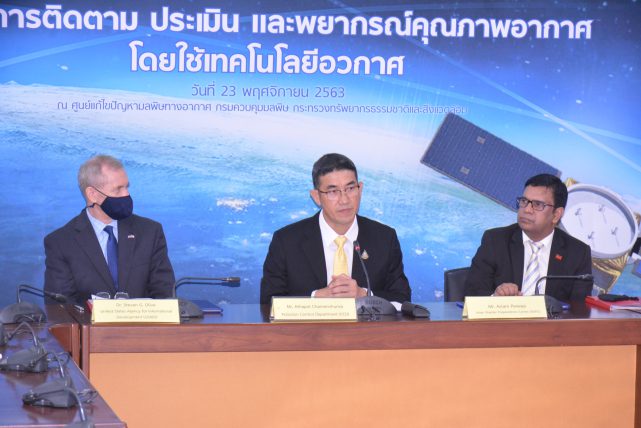
PCD has collaborated with the U.S. government on the development
of air quality monitoring, evaluating, and forecasting system by using space technology.
Mr. Athapol Charoenshunsa, Director General of Pollution Control Department (PCD) revealed that PCD has stated the collaboration with the U.S. government on the development of air quality monitoring, evaluating, and forecasting system by using space technology or “Mekong Air Quality Explorer” (http://aqatmekong-servir.adpc.net/en/mapviewer/). This system is such a tool for air pollution problem management through the collaboration with the U.S. Agency for International Development (USAID), the National Aeronautics and Space Administration (NASA), the Asian Disaster Preparedness Center (ADPC), the SERVIR-Mekong, and the Geo-informatics and Space Technology Development Agency (GISDA). The collaboration aims to address particulate matter problems under the Action Plan for driving national agenda “Pollution Problem Management (Particulate Matter)” which there is the operation as War Room to control, supervise, and oversee the related mission measures in case of situation occurrence. The related agencies have to strictly enhance the operation to mitigate situation to normal condition rapidly.
Mr. Athapol said that the air quality monitoring, evaluating, and forecasting system will help PCD report Thailand state of air pollution by processing result from satellite data and NASA’s 3-hour mathematics model system together with the operation of GISDA, Thailand’ major organization which is in charge of developing satellite data system for monitoring PM2.5 sources, hot spots, burning areas, dispersion and direction of particulate matter as well as area-based dispersion behaviour of PM2.5 both across and around the country at every 1-hour frequency level. These data have been supportably used for issuing guidance in order to make local people to get preparedness and prevent health effects. Moreover, the air quality monitoring, evaluating, and forecasting system is a tool to support data for “Burn Check” application for fuel management registration in agricultural areas as well.
Mr. Athapol also said that the collaboration on technology development mentioned above aims to enhance the operation on preventing and addressing PM2.5 problems by using up-to-date tools and technologies and knowledge from all related sectors to effectively and sustainably integrate PM2.5 addressing further.